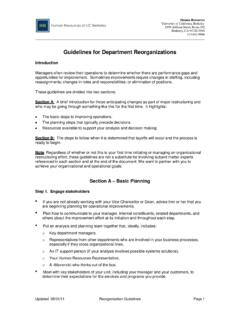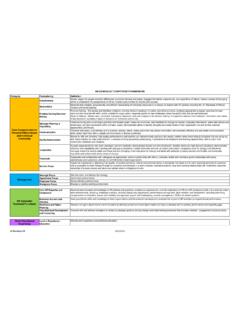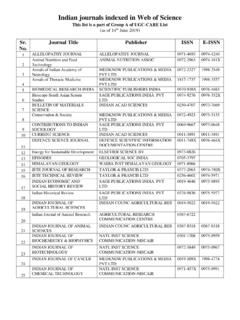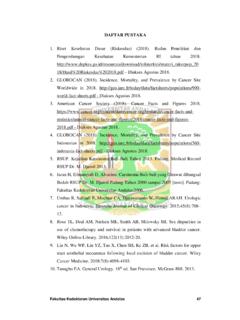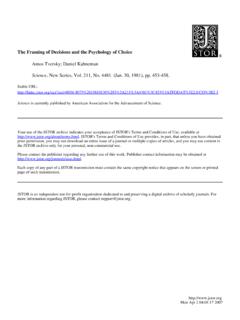Transcription of Microaggressions: Clarification, Evidence, and Impact
1 On Psychological Science2020, Vol. 15(1) 3 26 The Author(s) 2019 Article reuse guidelines: : FORPSYCHOLOGICAL SCIENCEA lthough it is no longer socially acceptable to be openly racist in America ( , Nadal, 2018), racism continues to be part of the fabric of American life. Racism can be defined as beliefs, attitudes, policies, and acts that deni-grate or disadvantage individuals or groups because of presumed racial or ethnic-group affiliation (R. Clark, Anderson, Clark, & Williams, 1999; Schmid, 1996). According to R. Clark et al. (1999), the conceptualiza-tion of racism can generally be placed into two broad categories: attitudinal ( , prejudice) or behavioral ( , discrimination); however, it is important to under-stand that racism is also structural in nature, in that it is woven into nearly all of our social systems, institu-tions, and policies for the benefit of White Americans at the expense of people of color (Salter, Adams, & Perez, 2018).
2 Individual and structural racism exist in synergy, each supporting the other. People of color experience racism in many forms, including covert acts of racial discrimination that go unseen and unacknowl-edged by offenders ( , Gaertner & Dovidio, 2005).Chester Pierce (1974), a prominent African American Harvard-trained psychiatrist, was the first to describe these covert acts as microaggressions in the 1960s. He defined microaggressions as black-white racial interac-tions [that] are characterized by white put-downs, done in an automatic, preconscious, or unconscious fashion (p. 515). Since that time, both popular use and the academic study of microaggressions have grown rapidly ( , Sue et al., 2007), and the definition has been expanded to describe this phenomenon when it occurs between various groups where there exists stigma and/or a power imbalance. In contrast to what Pierce (1970) called macroaggressions, which would include severe acts of racism ( , lynchings, beatings, cross burn-ings), microaggressions are considered small, common, and sometimes ambiguous, yet they are particularly stressful for those on the receiving end given their ubiquity and Lilienfeld (2017a,b) has critiqued both the con-ceptual basis for microaggressions as well as the scientific Author:Monnica T.
3 Williams, University of Ottawa, School of Psychology, 136 Jean-Jacques Lussier, Vanier Hall, Ottawa, Ontario, Canada, K1N 6N5 E-mail: Microaggressions: Clarification, Evidence, and ImpactMonnica T. WilliamsSchool of Psychology, University of OttawaAbstractIn a 2017 article in Perspectives on Psychological Science, Scott Lilienfeld critiqued the conceptual basis for microaggressions as well as the scientific rigor of scholarship on the topic. The current article provides a response that systematically analyzes the arguments and representations made in Lilienfeld s critique with regard to the concept of microaggressions and the state of the related research . I show that, in contrast to the claim that the concept of microaggressions is vague and inconsistent, the term is well defined and can be decisively linked to individual prejudice in offenders and mental-health outcomes in targets. I explain how the concept of microaggressions is connected to pathological stereotypes, power structures, structural racism, and multiple forms of racial prejudice.
4 Also described are recent research advances that address some of Lilienfeld s original critiques. Further, this article highlights potentially problematic attitudes, assumptions, and approaches embedded in Lilienfeld s analysis that are common to the field of psychology as a whole. It is important for all academics to acknowledge and question their own biases and perspectives when conducting scientific , racism, validity, ethnic differences, diversity, education4 Williamsrigor of academic scholarship on the topic. In a 2017 article published in this journal , he argued that the microaggres-sion research program rests on five faulty premises:1. Microaggressions are operationalized with suf-ficient clarity and consensus to afford rigorous scientific Microaggressions are interpreted negatively by most or all minority group Microaggressions reflect implicitly prejudicial and implicitly aggressive Microaggressions can be validly assessed using only respondents subjective Microaggressions exert an adverse Impact on recipients mental health.
5 (Lilienfeld, 2017b, p. 140)Some scholars have supported his critique ( , Haidt, 2017), and so it is critical that these points be addressed with sound reasoning and current empirical findings. This article will address each premise, using the existing literature base and my own research . Specifically, as elaborated in Table 1, I argue the following:1. Microaggressions are well Adequate agreement exists regarding what con-stitutes a Microaggressions are correlated with valid mea-sures of Microaggressions can be validly assessed using respondents subjective Microaggressions are linked to negative mental-health the basis of Pierce s original descriptions and current scholarship, I define microaggressions as deni-able acts of racism that reinforce pathological stereo-types and inequitable social norms. This definition is not based on the conscious intent of the offender or the perception of the target, although I will illustrate how microaggressions are related to racial biases, are offensive to many, and are harmful to victims.
6 Lilienfeld also made a number of additional claims and comments that deserve a response, but not all of the issues can be addressed here because of space issues, so in addi-tion to these five major premises, I address a few of his most problematic points in the discussion. Specifically, I argue that Lilienfeld s approach to understanding these issues uses a cultural-deficit model, that he endorsed what may amount to suppressing information about microaggressions,1 and that microaggression edu-cation can beneficially be taught to examining specific claims, I first address the approach to the scientific process. Although ultimately this article is aimed at systematically and carefully deconstructing Lilienfeld s arguments, claims, reason-ing, and misrepresentation of the state of microaggres-sion research , it is important for all academics to acknowledge and question their own biases and per-spectives when conducting research (Barber & Silver, 1968; Does et al.)
7 , 2018; Orne, 1962). This principle is inherent in statistical approaches for reducing confirma-tion bias and in the academic encouragement of open discussion and debate (Littell, 2008; Nickerson, 1998). In responding to Lilienfeld s article, I consciously choose to share my vantage point. Note that I approach this issue from my own perspective as a clinical psy-chologist, psychopathology researcher, disparities Table 1. Addressing Lilienfeld s Key AssertionsQuestioned assertionResponse1. Microaggressions are operationalized with sufficient clarity and consensus to afford rigorous scientific investigationMicroaggressions are well operationalized and can be identified on the basis of pathological ethnic or racial stereotypes, the content of which is dictated by legitimizing myths. The defining features of microaggressions are largely shared among diversity researchers, who have created many validated measures of microaggressions that have been used in several rigorous scientific Microaggressions are interpreted negatively by most or all minority group membersIt is not necessary for microaggressions to be interpreted negatively by all minorities for the construct to have meaning.
8 Nonetheless, the evidence suggests that most people of color agree that most microaggressions (as identified by researchers) are Microaggressions reflect implicitly prejudicial and implicitly aggressive motivesMicroaggressions are correlated to multiple indicators of racism, including symbolic racism, color-blind racial attitudes, modern racism, and explicit racial attitudes (feelings thermometer), and they are negatively correlated to positive feelings toward people of Microaggressions can be validly assessed using only respondents subjective reportsMicroaggressions are routinely assessed using validated self-report measures. Further, people of color, White people, and diversity experts alike largely agree as to what constitutes undesirable microaggressive Microaggressions exert an adverse Impact on recipients mental are correlated to numerous severe mental-health conditions, including suicidality. Correlations remain even after controlling for negative affectivity.
9 Several studies have examined the effects of microaggressions proactively to establish cause and effect. Thus microaggressions pose an important mental health 5researcher, psychometrician, behaviorist, diversity instructor, university educator, clinical supervisor, target of microaggressions, person of color, American, African American, and woman. Some of these identities are stigmatized ( , Black woman) and some are privi-leged ( , university professor). All of these identities are salient as they inform my approach, perspective, and priorities (Does et al., 2018). As part of my African American cultural values and ethnic/racial socialization, I value being clear, direct, and honest. I regularly expe-rience all forms of racism, probably more than most because of the relatively large platform I have to dis-seminate my antiracism work, but less so than some because of my privileged identities. I am an optimist and believe people can grow and change for the better.
10 All of us carry biases, and challenging ongoing personal work is needed to address microaggressions terminologyMuch of the scholarship surrounding microaggressions has focused on marginalized ethnic and racial groups that tend to be the targets of microaggressive behavior. The term started as a way to describe the common experiences of African Americans (Pierce, 1970; Smith, Allen, & Danley, 2007), but other groups experience frequent microaggressions as well, including Asian Americans (Nadal, Vigilia Escobar, Prado, David, & Haynes, 2012; Ong, Burrow, Fuller-Rowell, Ja, & Sue, 2013), Hispanic Americans (Huynh, 2012; Yosso, Smith, Ceja, & Sol rzano, 2009), Native Americans/American Indians ( Jones & Galliher, 2015; Walls, Gonzalez, Gladney, & Onello, 2015), Asian and Indigenous Canadians (Canel- narbas & Yohani, 2019; D. A. Clark, Kleiman, Spanierman, Isaac, & Poolokasingham, 2014; Poolokasingham, Spanierman, Kleiman, & Houshmand, 2014), and others.


